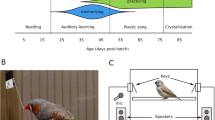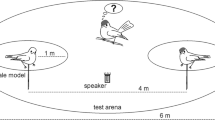Abstract
Song acquisition in young male zebra finches, Taeniopygia guttata, is viewed as a learning process by imitation from a visible conspecific male acting as a song tutor. The role played by non-singing conspecific females in this process has been poorly documented. The influence of social contact on the song learning of blindfolded young males was investigated in both female-raised and pair-raised birds. Pupils with both eyes occluded from about 35 to 65 days post-hatch, the sensitive phase for song learning, copied significantly more from an adult male sharing their cage when tutored in the presence of a female sibling than in her absence. Interestingly, the effect was more pronounced in female-raised birds compared to pair-raised birds. I conclude that physical contact in the absence of visual cues is sufficient for song imitation to occur. The results demonstrate an instance of social stimulation by non-singing females in the song acquisition of male songbirds.

Similar content being viewed by others
References
Adret P (1992) Imitation du chant chez les diamants mandarins: voir, entendre et interagir. Ann Fondation Fyssen 7:73–82
Adret P (1993) Operant conditioning, song learning and imprinting to taped song in the zebra finch. Anim Behav 46:149–159
Baptista LF, Gaunt SLL (1997) Social interaction and vocal development in birds. In: Snowdon CT, Hausberger M (eds) Social influences on vocal development. Cambridge University Press, Cambridge, pp 23–40
Beecher MD (1996) Birdsong learning in the laboratory and field. In: Kroodsma DA, Miller EH (eds) Ecology and evolution of acoustic communication in birds. Comstock, Ithaca, N.Y., pp 61–78
Bernstein PL, Zuo M, Cheng MF (1993) Social condition affects the courtship behavior of male ring doves with posterior medial hypothalamic lesions. Behav Neural Biol 59:120–125
Bolhuis JJ, Van Mil DP, Houx BB (1999) Song learning with audiovisual compound stimuli in zebra finches. Anim Behav 58:1285–1292
Catchpole CK, Slater PJB (1995) Bird song. Biological themes and variations. Cambridge University Press, Cambridge
Clayton NS (1987) Song tutor choice in zebra finches. Anim Behav 35:714–722
Clayton NS (1988) Song tutor choice in zebra finches and bengalese finches: the relative importance of visual and vocal cues. Behaviour 104:281–299
Dietrich K (1980) Vorbildwahl in der Gesangsentwicklung beim Japanischen Möwchen (Lonchura striata var. domestica, Estrildidae). Z Tierpsychol 52:57–76
Dooling RJ, Brown SD, Manabe K, Powell EF (1996) The perceptual foundations of vocal learning in budgerigars. In: Moss CF, Shettleworth SJ (eds) Neuroethological studies of cognitive and perceptual processes. Westview Press, Boulder, Colo., pp 113–137
Dufty AM Jr, Wingfield JC (1986) The influence of social cues on the reproductive endocrinology of male brown-headed cowbirds: field and laboratory studies. Horm Behav 20:222–234
Eales LA (1985) Song learning in zebra finches: some effects of song model availability on what is learnt and when. Anim Behav 33:1293–1300
Eales LA (1989) The influences of visual and vocal interaction on song learning in zebra finches. Anim Behav 37:507–508
Farabaugh SM, Linzenbold A, Dooling RJ (1994) Vocal plasticity in budgerigars (Melopsittacus undulatus): evidence for social factors in the learning of contact calls. J Comp Psychol 108:81–91
Freeberg TM, King AP, West MJ (1995) Social malleability in cowbirds (Molothrus ater artemisiae): species and mate recognition in the first 2 years of life. J Comp Psychol 109:357–367
Houx BB, ten Cate C (1998) Do contingencies with tutor behaviour influence song learning in zebra finches? Behaviour 135:599–614
Houx BB, ten Cate C (1999) Learning from playback tutor song in zebra finches: is there an effect of operant contingency? Anim Behav 57:837–845
Houx BB, ten Cate C, Feuth E (2000) Variations in zebra finch song copying: an examination of the relationship with tutor song quality and pupil behaviour. Behaviour 137:1377–1389
Hultsch H, Schleuss F, Todt D (1999) Auditory-visual stimulus pairing enhances perceptual learning in a songbird. Anim Behav 58:143–149
Immelmann K (1969) Song development in the zebra finch and other estrildid finches. In: Hinde RA (ed) Bird vocalizations. Cambridge University Press, Cambridge, pp 61–74
Jones AE, Slater PJB (1993) Do young male zebra finches prefer to learn songs that are familiar to females with which they are housed? Anim Behav 46:616–617
Jones AE, Slater PJB (1996) The role of aggression in song tutor choice in the zebra finch: cause or effect? Behaviour 133:103–115
King AP, West MJ (1983) Epigenesis of cowbird song: a joint endeavour of males and females. Nature 305:704–706
King AP, Freeberg TM, West MJ (1996) Social experience affects the process and outcome of vocal ontogeny in two populations of cowbirds (Molothrus ater). J Comp Psychol 110:276–285
Konishi M (1985) Birdsong: from behaviour to neuron. Annu Rev Neurosci 8:125–170
Kroodsma DA (1981) Ontogeny of birdsong. In: Immelmann K, Barlow GW, Petrinovich L, Main M (eds) Behavioural development. Cambridge University Press, Cambridge, pp 518–532
Kroodsma DA, Miller EH (1996) Ecology and evolution of acoustic communication in birds. Comstock Publishing, Ithaca, N.Y.
Mann NI, Slater PJB (1995) Song tutor choice by zebra finches in aviaries. Anim Behav 49:811–820
Mann NI, Slater PJB, Eales LA, Richards C (1991) The influence of visual stimuli on song tutor choice in the zebra finch, Taeniopygia guttata. Anim Behav 42:285–293
Marler P (1987) Sensitive periods and the roles of specific and general sensory stimulation in birdsong learning. In: Rauschecker JP, Marler P (eds) Imprinting and cortical plasticity. Wiley, New York, pp 99–135
Martin P, Bateson P (1986) Measuring behaviour. An introductory guide. Cambridge University Press, Cambridge
Morris D (1954) The reproductive behaviour of the zebra finch (Poephila guttata) with special reference to pseudofemale behaviour and displacement activities. Behaviour 6:271–322
Nelson DA (1997) Social interaction and sensitive phases for song learning: a critical review. In: Snowdon CT, Hausberger M (eds) Social influences on vocal development. Cambridge University Press, Cambridge, pp 7–22
Payne RB (1981) Song learning and social interaction in indigo buntings. Anim Behav 29:688–697
Pepperberg IM (1985) Social modeling theory: a possible framework for understanding avian vocal learning. Auk 102:854–864
Pepperberg IM (1994) Vocal learning in grey parrots (Psittacus erithacus): effects of social interaction, reference, and context. Auk 111:300–313
Price PH (1979) Developmental determinants of structure in zebra finch song. J Comp Physiol Psychol 2:260–277
Pröve E (1981) The influence of social housing conditions on sexual activity and androgen titers in male zebra finches (Taeniopygia guttata castanotis Gould). Verh D Zool Ges 1981:255
Slater PJB (1989) Bird song learning: causes and consequences. Ethol Ecol Evol 1:19–46
Slater PJB, Jones AE (1998) Practice and song development in zebra finches. Behaviour 135:1125–1136
Slater PJB, Eales LA, Clayton NS (1988) Song learning in zebra finches: progress and prospects. Adv Stud Behav 18:1–34
Snowdon CT, Hausberger M (1997) Social influences on vocal development. Cambridge University Press, Cambridge
Sossinka R, Böhner J (1980) Song types in the zebra finch Poephila guttata castanotis. Z Tierpsychol 53:123–132
Tchernichovski O, Nottebohm F (1998) Social inhibition of song imitation among sibling male zebra finches. Proc Natl Acad Sci USA 93:8951–8956
Tchernichovski O, Lints T, Mitra PP, Nottebohm F (1999) Vocal imitation in zebra finches is inversely related to model abundance. Proc Natl Acad Sci USA 96:12901–12904
Tchernichovski O, Mitra PP, Lints T, Nottebohm F (2001) Dynamics of the vocal imitation process: how a zebra finch learns its song. Science 291:2564–2569
ten Cate C (1986) Listening behaviour and song learning in zebra finches. Anim Behav 34:1267–1268
Thielke G (1970) Lernen von Gesang als möglicher Schrittmacher der Evolution. Z Zool Syst Evol 8:309–320
Todt D, Hultsch H, Heike D (1979) Conditions affecting song acquisition in nightingales (Luscinia megarhynchos L .). Z Tierpsychol 51:23–35
West MJ, King AP (1985) Social guidance of vocal learning by female cowbirds: validating its functional significance. Z Tierpsychol 70:225–235
West MJ, King AP (1988) Female visual displays affect the development of male song in the cowbird. Nature 334:244–246
West MJ, King AP (1990) Mozart's starling. Am Sci 78:106–114
West MJ, King AP (1996) Synergy and songbirds. In: Heyes CM, Galef Jr. BG (eds) Social learning in animals. The roots of culture. Academic Press, New York, pp 155–178
West MJ, King AP, Freeberg TM (1997) Building a social agenda for the study of birdsong. In: Snowdon CT, Hausberger M (eds) Social influences on vocal development. Cambridge University Press, Cambridge, pp 41–56
Williams H (1990) Bird song. In: Kesner RC, Olton DS (eds) Neurobiology of comparative cognition. Erlbaum, Hillsdale, N.J., pp 77–125
Acknowledgments
I am most indebted to Michael Beecher, Peter Slater and Meredith West for constructive comments on different versions of the manuscript. Two anonymous referees made useful suggestions. Petr Janata and Rick Rayborn kindly offered their help in scoring sonagrams. This work was supported by grants from the European Community and Fondation Fyssen.
Author information
Authors and Affiliations
Corresponding author
About this article
Cite this article
Adret, P. Vocal imitation in blindfolded zebra finches (Taeniopygia guttata) is facilitated in the presence of a non-singing conspecific female. J Ethol 22, 29–35 (2004). https://doi.org/10.1007/s10164-003-0094-y
Received:
Accepted:
Published:
Issue Date:
DOI: https://doi.org/10.1007/s10164-003-0094-y




